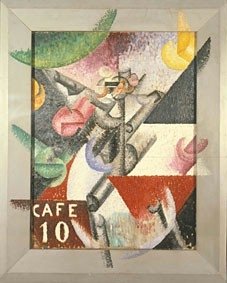Languages of Futurism
dal 1/10/2009 al 10/1/2010
Segnalato da
1/10/2009
Languages of Futurism
Martin Gropius Bau, Berlin
Literature, Painting, Sculpture, Music, Theatre, Photography. The exhibition is intended as a presentation and a tribute to the Art-Life project, to which Futurism gave theoretical form in its manifestos and systematically put into practice by means of a programme that envisaged the participation of all the arts in the construction of a new aesthetic of everyday life. The exhibition begins with an introductory section dealing with the upheavals in painting caused by the historical core group of Futurists around Boccioni, Balla, Severini, Russolo, Soffici and Carra'.

“We want to sing the love of danger, the habit of energy and rashness,” proclaimed the first
thesis of the radical and antibourgeois manifesto published in 1909 by Filippo Tommaso Marinetti
(himself the son of a bourgeois family) in the Paris daily Le Figaro. The Martin-Gropius-
Bau has taken the hundredth anniversary of the “Futurist Manifesto” as an occasion to devote
a major exhibition entitled “Languages of Futurism” to the “universal artwork Futurism”. In his
eleven-point manifesto Marinetti propagated a new culture embracing all areas of life.
The aim was to have all the arts participate in the construction of a new aesthetic of the everyday.
Whether photography or film, fashion or design, dance or literature, painting or sculpture,
architecture or music – there was no art form that the Futurists did not try their hand at.
Futurism enabled the Italian art of the early twentieth century to take its place among the main
avant-garde currents in Europe – especially those in France and Germany.
With its interest in
revolutionizing all the arts Futurism in Italy was in one sense an artistic movement, but it was
also a new way of looking at the cultural life of a country which entered the twentieth century in
a state of marked social and economic backwardness and profound divisions.
The exhibition “Languages of Futurism” arose in cooperation with Italienisches Kulturinstitut
Berlin and the Museo d’Arte Moderna e Contemporanea di Trento e Rovereto (MART), which
has a collection of over 4,000 futurist works, including masterpieces by Carrà, Severini, Russolo
and Balla, as well as an extensive archive of documents and books by the most important
representatives of the avant garde. The museum and study centre are supplemented by the
Casa Museo Depero, Italy’s first futurist museum, that was founded by Fortunato Depero himself
and opened in cooperation with the city of Rovereto in 1959. The director of the museum,
Gabriela Belli, curated the exhibition for Berlin. The cooperation with MART has made it possible
to present the whole range of forms of artistic expression used by Futurism – from painting
and architecture to literature.
The Berlin exhibition begins with an introductory section dealing with the upheavals in painting
caused by the historical core group of Futurists around Boccioni, Balla, Severini, Russolo,
Soffici and Carrà.
The focus of the exhibition, however, will be on the innovations that ushered
in a new, extraordinarily creative epoch of Futurism after Boccioni’s death in 1916. The Futurist
aesthetic expressed in the manifesto “Ricostruzione Futurista dell’Universo” (Futurist Reconstruction
of the Universe), that was published by Balla and Depero in March 1915, captures
all dimensions of the everyday world and reaches out to many aspects of life that are
unrelated to the plastic arts. The works of the second generation of Futurists, in particular –
people such as Balla, Severini, Soffici, Depero, Prampolini, Crali and Thayaht – reveal the
intention of using all forms of artistic expression, from design to advertising, from fashion to the
culinary arts, in order to find “futurist” solutions to everyday problems.
The presentation in Berlin thus offers an opportunity of finding out more about those aspects
of Futurism that are less well known than the paintings.
Devoting an exhibition to Futurism in Berlin is of particular significance as this city played an
important role in the Futurists’ dissemination of their revolutionary ideas in Germany thanks to
the efforts of Herwarth Walden (1887–1941). In 1912 the Futurist Manifesto was published in
Der Sturm, a periodical founded by Herwarth Walden and Alfred Döblin. Soon afterwards the
first Futurist exhibition in Germany was held in Walden’s eponymous gallery at Tiergartenstrasse
34a. It showed 35 pictures by the Futurists Boccioni, Carrà, Russolo and Severini and
attracted up to 1,000 visitors daily. Walden, Boccioni and Marinetti drove in a flashy open car
through the streets of Berlin distributing leaflets bearing the slogan “Eviva Futurista”. It was the
artistic event of the year 1912 in Berlin.
Marinetti, unquestionably the first great master of media communication strategies, was at war
– like all the painters who were close to Futurism – with the past, with history, with remembrance.
Under the slashing blows of his pamphlets and theoretical manifestoes the “cult objects”
of the past toppled one after another. He condemned the art of the Renaissance as he
did the Tango or the music of Wagner, the romanticization of Venice or love in the moonlight.
The name of the movement – which was Marinetti’s invention – was well suited to expressing
the absolute faith in the new technologies, especially the automobile and the aeroplane. Shuttling
back and forth between Paris and Milan, Marinetti brought Futurism to the whole of
Europe. Dadaism, Surrealism, Constructivism and Expressionism were all influenced by the
Futurists.
Further appearances by Futurists in Herwarth Walden’s periodical and gallery followed, as a
selection of documents in the Martin-Gropius-Bau exhibition makes clear.
Organizers:
Berliner Festspiele. An exhibition of the Museo d´Arte Moderna e Contemporanea di Trento e
Rovereto in cooperation with Italienisches Kulturinstitut Berlin. Sponsored by the Embassy of
the Italian Republic.
Press contact:
artpress – Ute Weingarten, Marie Skov
E-mail: presse@gropiusbau.de
Media partners:
RBB Inforadio, RBB Kulturradio, die tageszeitung, Exberliner
Image: Gino Severini, Ritmo plastico del 14 luglio, 1913
Martin Gropius Bau
Niederkirchnerstrasse 7 - Berlin
Opening hours: Wed – Mon 10 a.m. – 8 p.m., closed on Tuesdays



